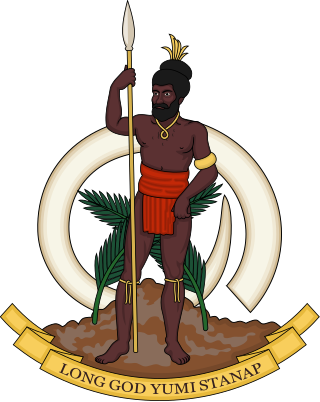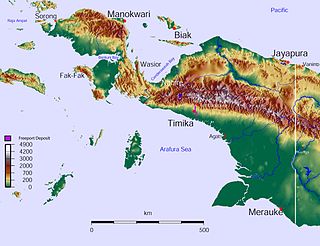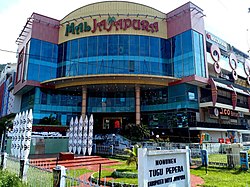
Dutch New Guinea or Netherlands New Guinea was the western half of the island of New Guinea that was a part of the Dutch East Indies until 1949, later an overseas territory of the Kingdom of the Netherlands from 1949 to 1962. It contained what are now Indonesia's six easternmost provinces, Central Papua, Highland Papua, Papua, South Papua, Southwest Papua, and West Papua, which were administered as a single province prior to 2003 under the name Irian Jaya, and now comprise the Papua region of the country.

The Free Papua Movement or Free Papua Organization is an independence movement based on Western New Guinea, seeking liberation of the territory from colonial Indonesian administration. The territory is currently divided into six Indonesian provinces of Central Papua, Highland Papua, Papua, South Papua, Southwest Papua, and West Papua, also formerly known as Papua, Irian Jaya and West Irian.

The Republic of West Papua, alternatively known as the Federal Republic of West Papua is a quasi-state consisting of the Western New Guinea region, which is currently part of Indonesia on the continent of Oceania. The region has been part of Indonesia since 1 May 1963 under several names in the following order, West Irian, Irian Jaya, and Papua. Today the region comprises six Indonesian provinces: Papua, Central Papua, Highland Papua, South Papua, West Papua, and Southwest Papua.

The New York Agreement is an agreement signed by the Netherlands and Indonesia regarding the administration of the territory of Western New Guinea. The first part of the agreement proposes that the United Nations assume administration of the territory, and a second part proposes a set of social conditions that will be provided if the United Nations exercises a discretion proposed in article 12 of the agreement to allow Indonesian occupation and administration of the territory. Negotiated during meetings hosted by the United States, the agreement was signed on 15 August 1962 at the United Nations Headquarters in New York City, United States.

Western New Guinea, also known as Papua, Indonesian New Guinea, and Indonesian Papua, is the western half of the island of New Guinea granted to Indonesia in 1962. Given the island is alternatively named Papua, the region is also called West Papua.
Dortheys Hiyo Eluay was an Indonesian local politician from Irian Jaya turned West Papuan independence activist. Known as the former leader of Papua Presidium Council, he was known as the community leader in West Papua region. He was murdered by members of the Indonesian Army special forces command.

The United Liberation Movement for West Papua (ULMWP) is an organization formed from the merger of three political independence movements seeking independence for Western New Guinea from Indonesia. The ULMWP was formed on 7 December 2014 in Vanuatu uniting the Federal Republic of West Papua (NRFPB), the West Papua National Coalition for Liberation (WPNCL) and the National Parliament of West Papua (NPWP).

Guided Democracy was the political system in place in Indonesia from 1959 until the New Order began in 1966. It was the brainchild of President Sukarno, and was an attempt to bring about political stability. Sukarno believed that the parliamentarian system implemented during the liberal democracy period in Indonesia was ineffective due to its divisive political situation at that time. Instead, he sought a system based on the traditional village system of discussion and consensus, which occurred under the guidance of village elders. With the declaration of martial law and the introduction of this system, Indonesia returned to the presidential system and Sukarno became the head of government again.

Frans Kaisiepo was a Papuan politician and Indonesian nationalist. He served as the fourth Governor of Papua Province. In 1993, Kaisiepo was posthumously declared a National Hero of Indonesia for his lifelong efforts to unite West Irian with Indonesia. As the representative of Papua province, he was involved in the Malino Conference, where the formation of the United States of Indonesia was discussed.

United Nations Administered West New Guinea refers to the period between 1 October 1962 and 1 May 1963 when Western New Guinea was administered by the United Nations Temporary Executive Authority (UNTEA) in accordance with in article two of the New York Agreement reached between the governments of the Netherlands and Indonesia in August 1962.

The Republic of Vanuatu has been a member of the United Nations since the year of its independence in 1980. The country was a particularly active member in the 1980s, when, governed by Prime Minister Father Walter Lini and represented by Ambassador Robert Van Lierop, it was a consistent advocate for decolonisation. Subsequently, its emphasis within the United Nations shifted to the issue of climate change and the vulnerability of Small Island Developing States.

New Guinea is the world's second-largest island, with an area of 785,753 km2 (303,381 sq mi). Located in Melanesia in the southwestern Pacific Ocean, the island is separated from Australia by the 150-kilometre wide Torres Strait, though both landmasses lie on the same continental shelf, and were united during episodes of low sea level in the Pleistocene glaciations as the combined landmass of Sahul. Numerous smaller islands are located to the west and east. The island's name was given by Spanish explorer Yñigo Ortiz de Retez during his maritime expedition of 1545 due to the resemblance of the indigenous peoples of the island to those in the African region of Guinea.

The Papua conflict is an ongoing conflict in Western New Guinea (Papua) between Indonesia and the Free Papua Movement. Subsequent to the withdrawal of the Dutch administration from the Netherlands New Guinea in 1962 and implementation of Indonesian administration in 1963, the Free Papua Movement has conducted a low-intensity guerrilla war against Indonesia through the targeting of its military, police, as well as civilian populations.
The History of Western New Guinea refers to the history of the Indonesian western half of the island of New Guinea and other smaller islands to its west. This region was previously named Irian Jaya. The eastern half of the island is Papua New Guinea.

Operation Trikora was a combined Soviet-Indonesian military operation which aimed to seize and annex the Dutch overseas territory of Netherlands New Guinea in 1961 and 1962. After negotiations, the Netherlands signed the New York Agreement with Indonesia on 15 August 1962, relinquishing control of Western New Guinea to the United Nations.

The West New Guinea dispute (1950–1962), also known as the West Irian dispute, was a diplomatic and political conflict between the Netherlands and Indonesia over the territory of Dutch New Guinea. While the Netherlands had ceded sovereignty over most of the Dutch East Indies to Indonesia on 27 December 1949 following an independence struggle, it retained control over its colony on the western half of New Guinea. The Indonesian government claimed this territory as well, on the basis that it had belonged to the Dutch East Indies and that the new Republic of Indonesia was the legitimate successor to the former Dutch colony.

West Irian Liberation Monument is a postwar modernist monument located in Jakarta, Indonesia. It is located in the center of Lapangan Banteng in Sawah Besar, Central Jakarta. Sukarno, then President of Indonesia, commissioned the monument in 1963 following the West New Guinea dispute in which Indonesia received the territory of Western New Guinea from the Netherlands.
In early 1976, the Indonesian Army launched an offensive against Free Papua Movement (OPM) military elements in the southern parts of Jayapura Regency, in what is today Papua. While the operation failed to completely destroy OPM's presence, the organization was considerably weakened militarily from its losses.
Seth Jafeth Rumkorem was a West Papuan military officer and independence activist. He chose to defect from the Indonesian Army to the Free Papua Movement (OPM) after witnessing electoral fraud and human rights abuses conducted by the former. He quickly became the leader of the movement's armed wing and was among the signatories of the proclamation of the Republic of West Papua. He went into exile to Greece, after an attempt to secure weapons for OPM went wrong. He eventually relocated to the Netherlands, where he continued his activism until his death in 2010.

Ramses Ohee was a Papuan-Indonesian pharmacist and politician who served as a member of the Jayapura Regional People's Representative Council from 1992 to 1999, and as an appointed member of the Papuan People's Representative Council from 2017 to 2019, and from 2021 until his death. Previously, he worked as an advisor to the government of Netherlands New Guinea and as a pharmacist in the health service of Netherlands New Guinea and the West Irian province.















